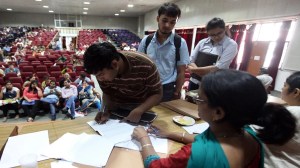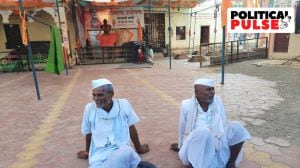- India
- International
Inside India’s largest cancer hospital
As the NCI starts operations in Jhajjar, The Indian Express on its scale, its firsts, and its planned reach — spanning from PHCs in remotest India to premier hospitals abroad.
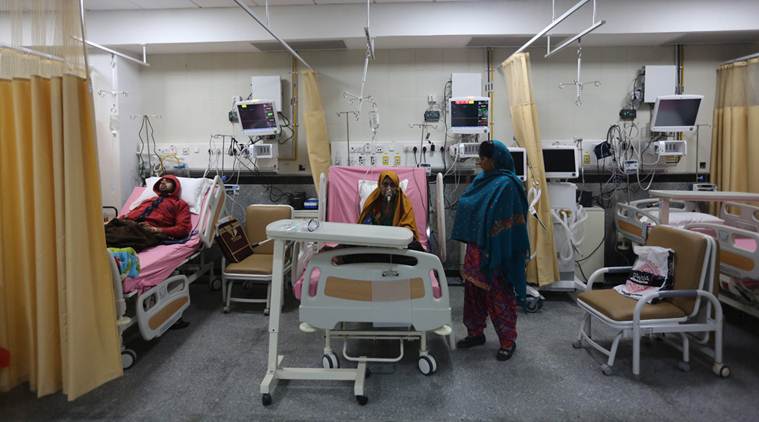 The dedicated Oncology Emergency on the ground floor of the hospital block. The facility has 30 beds and a dedicated Operation Theatre. (Express photo: Tashi Tobgyal)
The dedicated Oncology Emergency on the ground floor of the hospital block. The facility has 30 beds and a dedicated Operation Theatre. (Express photo: Tashi Tobgyal)
With the country battling a cancer crisis, the National Cancer Institute was promised by the government as the ‘badshaah’ of all health institutes. As the NCI starts operations in Jhajjar, The Indian Express on its scale, its firsts, and its planned reach — spanning from PHCs in remotest India to premier hospitals abroad.
I am a teacher, I like to talk, give lectures. So you have no choice but to listen to me. I hope you don’t mind,” says Professor G K Rath to a group of cancer researchers from the US who have come to meet him, in his chamber at Dr B R Ambedkar Institute Rotary Cancer Hospital at AIIMS in New Delhi.
What he says next grabs their attention. Zooming in on a slide on his computer, Rath says, “This is our Manhattan Project.”
“Your Manhattan Project?” asks a surprised guest.
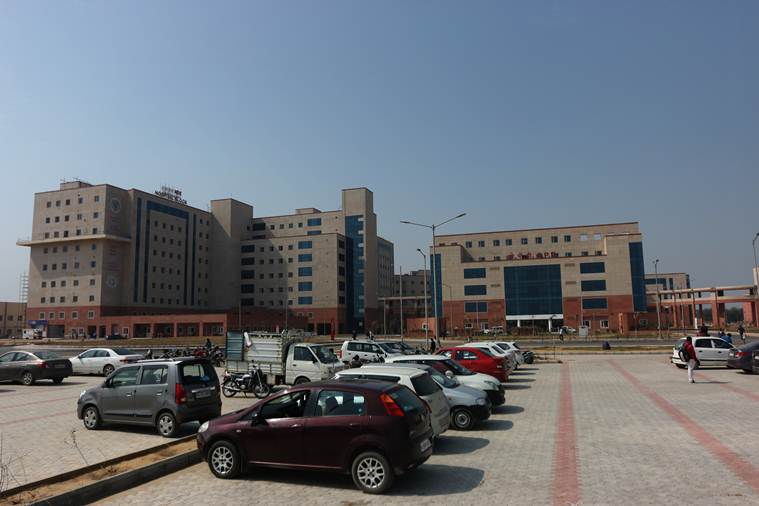 The OPD block, the hospital block and research block of the NCI. (Express photo: Tashi Tobgyal)
The OPD block, the hospital block and research block of the NCI. (Express photo: Tashi Tobgyal)
Rath, the head of the National Cancer Institute (NCI), India’s largest cancer hospital, beams. “The US and its allies started research on nuclear bombs in 1939 and, by World War II, they were ready with one. That was your Manhattan Project. This 70-acre land I’m showing you, that is where our Manhattan Project will begin.”
If that Manhattan Project hastened the end of WWII, this too will help India fight a war, the one against cancer, the professor asserts.

As per the Indian Council of Medical Research, India will have over 17.3 lakh cancer cases by 2020 — a doubling of cases in 25 years. It may see over 8.8 lakh deaths due to the disease, with only 12.5 per cent of the patients receiving treatment in early stages.

Last year, the WHO listed cancer as the second leading cause of death in the world, responsible for 9.6 million deaths.
AIIMS Director Dr Randeep Guleria, in whose tenure the NCI has taken shape, says the NCI has been modelled to address this shift in the disease profile, with non-communicable diseases now accounting for 60 per cent of all deaths every year in India. “India is experiencing a health transition. To tackle this, we need to address managing of patients and early diagnosis of cancer. The NCI will address these issues.”
Inaugurated by Prime Minister Narendra Modi on February 13 at the AIIMS, Jhajjar Campus, the NCI is India’s largest public-funded hospital, with total spending of Rs 2,035 crore. By the time it is completed in December 2020, the state-of-the-art hospital-cum-research institute will have over 700 beds exclusively for cancer patients. Most importantly, like at AIIMS, Delhi, most of the treatment, procedures would be free.
“The NCI will not be just a hospital for cancer treatment. It will be a pioneer in cancer prevention, care and research, all under one roof. In that order,” says Prof Rath.
******
Laying the foundation stone for a 300-acre second AIIMS campus at Bhadsa village in Jhajjar, Haryana, in 2012, 44 km from AIIMS, Delhi, then Union health minister Ghulam Nabi Azad had said the hospital would be “Baadshah (emperor)” of all health institutes. Clearing the setting up of the NCI a year later, the Cabinet noted that it was meant to “lessen the deficit of tertiary cancer care in Northern Region”.
Dr Rath says the need for a second campus was felt due to the patient pressure at AIIMS, Delhi. “We also needed space for equipment for cancer research. A decision was therefore taken to set up a dedicated cancer centre.” The NCI now occupies 70 of the 300 acres at the Jhajjar campus.
A fully functional NCI would cater to five lakh patients a year, and have 700 beds for cancer patients, 25 operation theatres, 60 ICU beds, a dedicated oncology emergency, 12 laboratories for cancer research, a fully automated lab to test samples and a bio bank facility for storing these for research purposes, housing for 372 doctors, and 640 senior and junior residents, 60 consultant rooms, and a waiting area for 1,200 patients.
Its facilities include a 4D CT scan, ‘bunkers’ against any radiation exposure, LINACS (Linear particle accelerators) for radiation treatment, and a machine for brachy-therapy — many of these a first in India.
In the basement of Block A of the OPD block, where the nuclear medicine and radiation therapy services are being set up, Chief Technical Officer A K Suman says the 4D CT scan is “the next step of imaging”. “It captures the fourth coordinate, time, giving an idea of the location and movement of a tumour and the body’s organs,” he says, adding that it has been introduced keeping in mind the high prevalence of cancer of the chest in India. Chest cancer includes breast and lung cancer, which are the two most common cancers in the country.
The two LINACS systems, installed for Rs 22 crore, are awaiting clearance from the Atomic Energy Regulatory Board to certify that the radiation exposure in them is within permissible limits. “These will operate 18 hours a day, with over 20 patients availing the service daily,” Suman says.
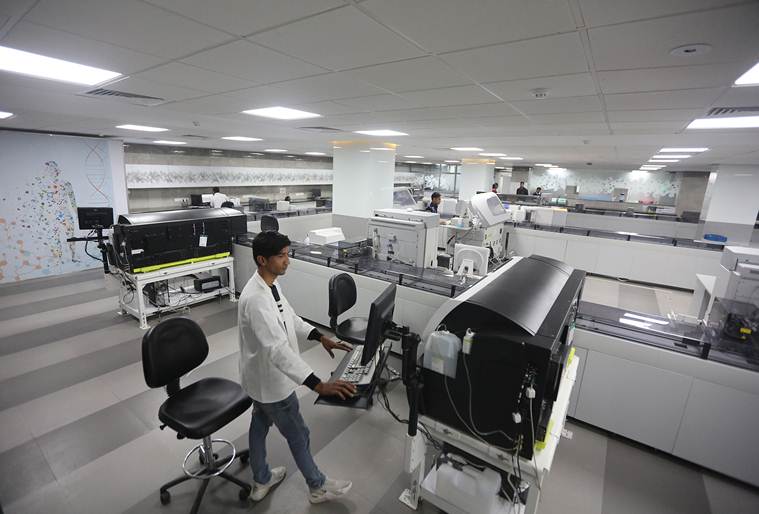 The fully automated core lab that can handle 60,000 tests per day, hand out reports in two hours. (Express photo: Tashi Tobgyal)
The fully automated core lab that can handle 60,000 tests per day, hand out reports in two hours. (Express photo: Tashi Tobgyal)
Brachytherapy, which involves insertion of radioactive implants directly into the tissue, is to be used in cervical, prostate, breast and skin cancers. Cervical cancer is the third most common cancer in India. As per the National Institute of Cancer Prevention and Research, a woman dies of cervical cancer every eight minutes in India. Prostate, among the top 10 cancers in India, saw around 47,000 cases and over 17,000 deaths in the past five years. Among the most common cancers in India, breast cancer kills one of every two women it afflicts in the country.
The Robotic Core Laboratory, the first of its kind in India, is up and running, spread over 4,500 sq ft in the diagnostic block. Ashish, a technician stationed at one of the 70 points across the NCI, collects samples of patients, barcodes them and sends them for examination with the click of a button. “Within 30 seconds, these samples reach the lab. There are seven different channels through which the samples reach the lab. If it is busy, the samples automatically take a different one,” Ashish explains.
At the lab, two technicians handle storage of the samples. “With just two technicians and a doctor, 60,000 tests can be conducted in a day. Patients can receive test results in two hours,” says Gajendra , the Quality & Assurance Engineer at the lab.
Besides allowing them to handle a larger number of patients, Dr Guleria says, the lab would help cut errors and save man hours substantially. “This is the first step towards digitally enabled healthcare system. It will set a benchmark for other hospitals.”
******
There is another “first”, Dr Guleria points out: a paperless hospital. The NCI will have fully digitised patient records, including of those in ICUs. While easing administration is one reason, digitisation is part of another ambitious initiative at the NCI — disseminating information gathered here on cancer prevention right down to primary health centres across the country.
“The government is already implementing the National Programme for Prevention and Control of Cancer, Diabetes, CVD (Cardiovascular Disease) and Stroke. PHCs already screen oral, cervical and breast cancers under it. The NCI will now function as a hub and the other centres the spokes connected to it. We want the entire country to gain from NCI research,” Dr Guleria says.
The National Programme for Prevention and Control of Cancer, Diabetes, CVD and Stroke was launched in 2010 to address the alarming rise of non-communicable diseases (NCDs) in India. Being implemented under the National Health Mission, the programme currently includes 436 District NCD Cells, 435 District NCD Clinics, and 2,145 Community Health Centre NCD Clinics, screening for NCDs.
Besides, there is a National Cancer Grid since 2012 linking more than 160 major cancer centres and research institutes, including private ones.
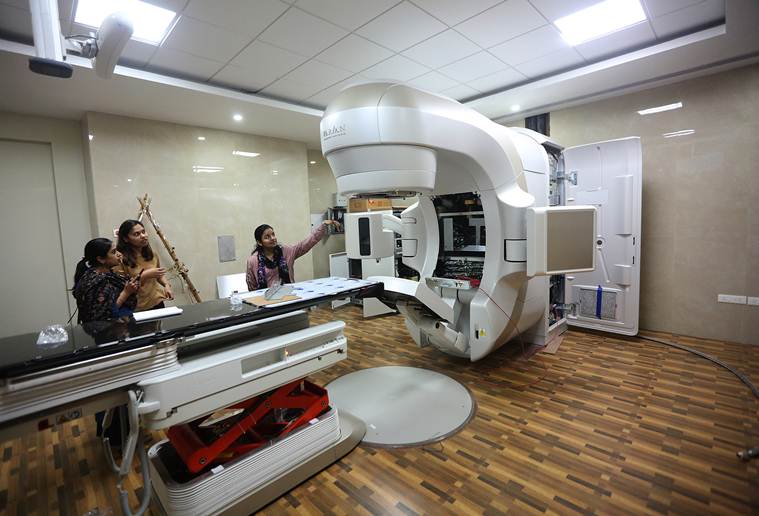 A LINACS machine for radiation treatment. (Express photo: Tashi Tobgyal)
A LINACS machine for radiation treatment. (Express photo: Tashi Tobgyal)
Underlining how all this has the potential to change cancer care and cure, Prof Rath says, “In cancer, different patients respond to a medicine or treatment differently. Once all this is stored digitally, we will be able to build algorithms for better treatment options and modalities.”
It would also address questions like why the incidence of breast cancer in Badsi village in Maharashtra, for example, is 9 per 1 lakh population, compared to 40 for Delhi, Rath says. “We will seeks answers to questions like why gall bladder cancer occurs predominantly in North India, and why India has a higher incidence of oral cancer and cervical cancer compared to the US.”
In this, the NCI will also be collaborating with global premier cancer research institutes like the National Cancer Institute of the US, La Fondation De L’Academie de Medecine of France, and the Barts Cancer Institute of Queen Mary University, London.
Dr Guleria adds that they are open to collaborating with institutes offering alternative treatments as well. “Many terminally ill patients prefer such treatments. At the NCI, we will test the efficacy of such drugs, including Ayurvedic medicines.”
 Patient assistance room in the OPD block, which has 60 consultant rooms and a waiting area that can accommodate 1,200 people. (Express photo: Tashi Tobgyal)
Patient assistance room in the OPD block, which has 60 consultant rooms and a waiting area that can accommodate 1,200 people. (Express photo: Tashi Tobgyal)
Lakshmikant Sharma, one of the nurses at an NCI ICU, who underwent training in updating patient data on computers, marvels, “I can even monitor doses of different patients from a single point. Also, consultants travelling to conferences can continue to track patients from here.”
******
Currently, hectic work is on to have the surgical services up and running. The NCI is to have 25 fully integrated, modular operation threatres, controlled via a central command. “We also have cameras to record surgeries for future reference and to share with other centres,” says Dr S V S Deo, the Head of Surgical Oncology at AIIMS.
The NCI aims to cut treatment duration via “intra-operative therapy”. “Radiation therapy will be administered during surgery itself so that patients don’t have to wait six weeks to begin it after an operation. The surgery and radiation will finish within a few hours,” Dr Deo says.
Apart from treatment, the NCI will focus on prevention. Underlining the significance of this, Dr Deo says, “Very little is discussed regarding cancer prevention when we talk about surgical oncology. But that will change. For example, there is a lot of data on genetic testing in cancer. We will counsel patients if we find evidence that they have a probability of acquiring cancer… Many common cancers of colon, thyroid, ovaries and testes can be prevented.”
At a marathon meeting last week at the NCI to discuss surgical services, one of those present was Dr Sushma Bhatnagar, Head of Onco-Anaesthesia, who is working on another aspect of cancer little talked about in India: pain and palliative care.
“In India, cancer cases are reported at the last stage. The patient might be suffering physical pain due to chemotherapy or radiation, as well as social pain. The differences in culture and support systems may result in different palliative care needs,” Dr Bhatnagar says, adding that some patients are worried about the fate of their families, while others grapple with loss of faith.
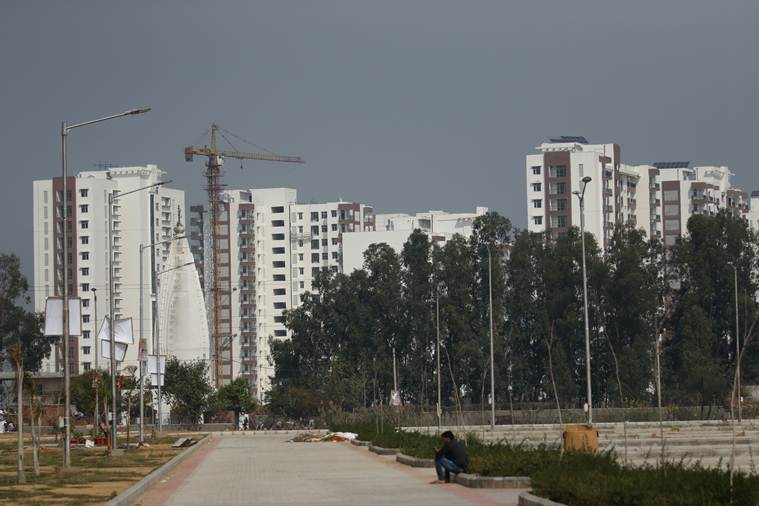 A residential complex being built for the faculty and resident doctors at NCI. (Express photo: Tashi Tobgyal)
A residential complex being built for the faculty and resident doctors at NCI. (Express photo: Tashi Tobgyal)
“Our main aim is to communicate to the patient and family that pain can be controlled and relieved. We will have a dedicated 40-bed facility just for palliative care.”
******
The first patients started trickling in on February 13 — and now the NCI has 30-40 patients per day at the OPD. One recent morning, among those at the OPD is Madan Mohan Arora, 57, who has come 222 km from Yamuna Nagar district in Haryana. The businessman has been diagnosed with lung cancer and is advised a higher dosage. “I read an article about the NCI. Since it was part of AIIMS, I didn’t think twice,” he says.
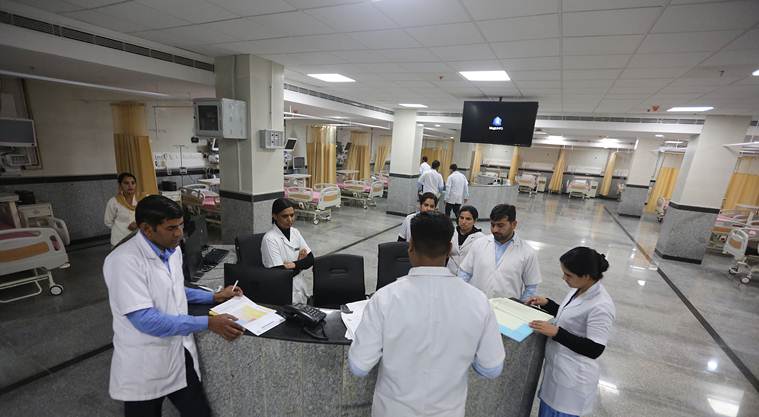 There is a National Cancer Grid since 2012 linking more than 160 major cancer centres and research institutes, including private ones. (Express photo: Tashi Tobgyal)
There is a National Cancer Grid since 2012 linking more than 160 major cancer centres and research institutes, including private ones. (Express photo: Tashi Tobgyal)
Also in the OPD are Revati, 60, and son Sunil, from Bharawas in Rewari. Sunil says he came to know of the NCI via Facebook. “My mother has a lump in the breast. We still don’t know the diagnosis,” he says, adding it is the AIIMS tag that drew them too.
As Revati sits silently awaiting her turn, one of the ‘patient care coordinators’, Lalita, briefs her. The 29-year-old, who has a qualification in hospital administration and is among the contractual staff at the NCI, says, “A lot of patients here have come for cancer treatment for the first time. They need guidance. We ensure that before a patient meets the doctor, everything is in place. Also, after consultation, we guide them.”
At the Emergency unit, two patients are being monitored by four doctors. Suman, 56, has been diagnosed with breast cancer and is being referred to surgical oncology. “We are waiting for her husband to bring the final reports,” nursing officer Ravi says.
The other patient, a farmer from Lohari Jatru, was rushed to the NCI after he experienced pain in his abdomen and had blood in his stool. He sits silently looking at the central station where doctors are discussing his file. Ravi murmurs, “He does not know he has been diagnosed with colon cancer.”
For now, it’s AIIMS consultants who are handling cases at the NCI as the system is still being put into place. Only non-faculty positions like nursing, pharmacist have been filled exclusively for the NCI. Authorities say hiring will be done phase-wise for the over 1,000 positions estimated at the NCI, including faculty, resident doctors.
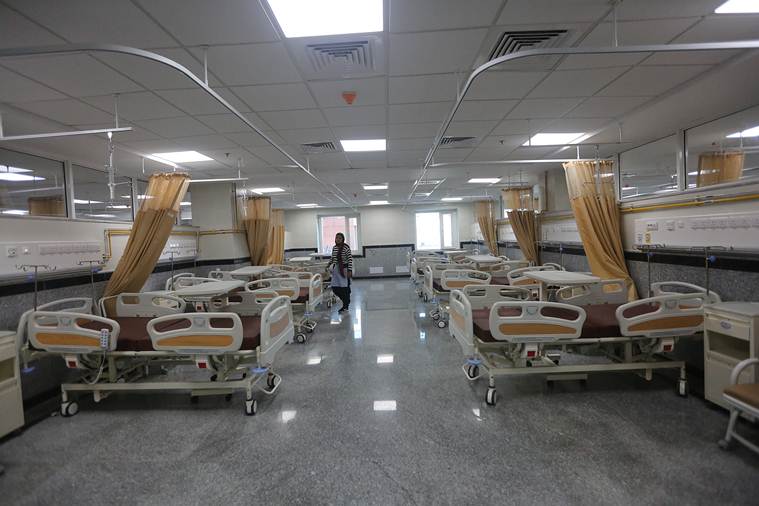 For now, it’s AIIMS consultants who are handling cases at the NCI as the system is still being put into place. (Express photo: Tashi Tobgyal)
For now, it’s AIIMS consultants who are handling cases at the NCI as the system is still being put into place. (Express photo: Tashi Tobgyal)
Prof Rath says there can’t be any other way. “Cancer in India is based on a 80-20 formula — 20 per cent patients in Stages 1 and 2, and cure rate is 80 per cent. Eighty per cent patients come in Stages 3 and 4, and cure rate is 20 per cent. So effectively, 80 per cent patients don’t get a cure,” he points out.
But, things can change, Rath asserts. “Twenty years ago in India, the rate of cervical cancer was 30 in a population of 1 lakh. Today it is 13. We will be Sweden in 15 years, where cervical cancer has been finished because of vaccination.”
Apr 24: Latest News
- 01
- 02
- 03
- 04
- 05















